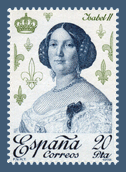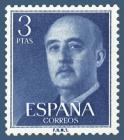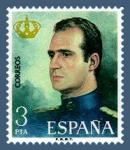 Spanish concordats of the 19th and 20th centuries
Spanish concordats of the 19th and 20th centuries
Queen Isabella's concordat of 1851 was abrogated in 1931, but General Franco, restored Church privileges in his concordat of 1953 (for which the pope decorated him). However, he guarded his right to appoint bishops, and only his death allowed the pope to regain control of the clergy through a new concordat in 1976. By then the Vatican was obliged to agree to more separation of church and state.
Below are excerpts of a text prepared by the Federal Research Division of the US Library of Congress
♦ Queen Isabella's Concordat (1851, abrogated 1931)
 Catholicism became the state religion in 1851, when the Spanish government signed a Concordat with the Vatican that committed Madrid to pay the salaries of the clergy and to subsidise other expenses of the Roman Catholic Church. This pact was renounced in 1931, when the secular constitution of the Second Republic imposed a series of anticlerical measures that threatened the church's very existence in Spain and provoked its support for the Franco uprising five years later.
Catholicism became the state religion in 1851, when the Spanish government signed a Concordat with the Vatican that committed Madrid to pay the salaries of the clergy and to subsidise other expenses of the Roman Catholic Church. This pact was renounced in 1931, when the secular constitution of the Second Republic imposed a series of anticlerical measures that threatened the church's very existence in Spain and provoked its support for the Franco uprising five years later.
[Editor's note: "Threatened the church's very existence?" The Spanish Constitution of 1931 removed Catholicism as the state religion, withdrew state subsidies for the Church, and brought in civil marriage, divorce and the vote for women — all things that in the Catholic Church has learned to live with, when it must.]
♦ Generalissimo Franco's Concordat (1953, amended 1976)
The advent of the Franco regime saw the restoration of the church's privileges. During the Franco years, Roman Catholicism was the only religion to have legal status; other worship services could not be advertised, and only the Roman Catholic Church could own property or publish books.
 The government not only continued to pay priests' salaries and to subsidise the church, but it also assisted in the reconstruction of church buildings damaged by the war. Laws were passed abolishing divorce and banning the sale of contraceptives. Catholic religious instruction was mandatory, even in public schools. Franco secured in return the right to name Roman Catholic bishops in Spain, as well as veto power over appointments of clergy down to the parish priest level. In 1953 this close cooperation was formalised in a new Concordat with the Vatican that granted the church an extraordinary set of privileges: mandatory canonical marriages for all Catholics; exemption from government taxation; subsidies for new building construction; censorship of materials the church deemed offensive; the right to establish universities, to operate radio stations, and to publish newspapers and magazines; protection from police intrusion into church properties; and exemption of clergy from military service.
The government not only continued to pay priests' salaries and to subsidise the church, but it also assisted in the reconstruction of church buildings damaged by the war. Laws were passed abolishing divorce and banning the sale of contraceptives. Catholic religious instruction was mandatory, even in public schools. Franco secured in return the right to name Roman Catholic bishops in Spain, as well as veto power over appointments of clergy down to the parish priest level. In 1953 this close cooperation was formalised in a new Concordat with the Vatican that granted the church an extraordinary set of privileges: mandatory canonical marriages for all Catholics; exemption from government taxation; subsidies for new building construction; censorship of materials the church deemed offensive; the right to establish universities, to operate radio stations, and to publish newspapers and magazines; protection from police intrusion into church properties; and exemption of clergy from military service.
♦ King Juan Carlos' Concordat (1976)
In the late 1960s, the Vatican attempted to reform the church in Spain by appointing liberals as interim, or acting, bishops, thereby circumventing Franco's stranglehold on the country's clergy. In 1966 the Franco regime passed a law that freed other religions from many of the earlier restrictions, although it also reaffirmed the privileges of the Catholic Church. Any attempt to revise the 1953 Concordat met the dictator's rigid resistance.
 In 1976, however, King Juan Carlos de Bourbon unilaterally renounced the right to name the bishops; later that same year Madrid and the Vatican signed a new accord that restored to the church its right to name bishops, and the church agreed to a revised Concordat that entailed a gradual financial separation of church and state. Church property not used for religious purposes was henceforth to be subject to taxation, and gradually, over a period of years, the church's reliance on state subsidies was to be reduced. The timetable for this reduction was not adhered to, however, and the church continued to receive the public subsidy through 1987 (US$110 million in that year alone). Indeed, by the end of 1987 issues such as financing and education had not been definitively resolved, and the revised Concordat still had not been agreed to in final form, even though the 1953 Concordat had expired in 1980.
In 1976, however, King Juan Carlos de Bourbon unilaterally renounced the right to name the bishops; later that same year Madrid and the Vatican signed a new accord that restored to the church its right to name bishops, and the church agreed to a revised Concordat that entailed a gradual financial separation of church and state. Church property not used for religious purposes was henceforth to be subject to taxation, and gradually, over a period of years, the church's reliance on state subsidies was to be reduced. The timetable for this reduction was not adhered to, however, and the church continued to receive the public subsidy through 1987 (US$110 million in that year alone). Indeed, by the end of 1987 issues such as financing and education had not been definitively resolved, and the revised Concordat still had not been agreed to in final form, even though the 1953 Concordat had expired in 1980.
♦ Concordats of 1979
It took the new 1978 Constitution to confirm the right of Spaniards to religious freedom and to begin the process of disestablishing Catholicism as the state religion. The concordats of 1979 reflect this change.
Government financial aid to the church was a difficult and contentious issue. The church argued that, in return for the subsidy, the state had received the social, health, and educational services of tens of thousands of priests and nuns who fulfilled vital functions that the state itself could not have performed. Nevertheless, the revised Concordat was supposed to replace direct state aid to the church with a scheme that would allow taxpayers to designate a certain portion of their taxes to be diverted directly to the church. Through 1985, taxpayers were allowed to deduct up to 10 percent from their taxable income for donations to the Catholic Church. Partly because of the protests against this arrangement from representatives of Spain's other religious groups, the tax laws were changed in 1987 so that taxpayers could choose between giving 0.52 percent of their income tax to the church and allocating it to the government's welfare and culture budgets. For three years, the government would continue to give the church a gradually reduced subsidy, but after that the church would have to subsist on its own resources. The government would continue, however, its program of subsidising Catholic schools, which in 1987 cost the Spanish taxpayers about US$300 million, exclusive of the salaries of teachers, which were paid directly by the Ministry of Education and Science.
Source:
Edited by Eric Solsten and Sandra W. Meditz. Prepared by Library of Congress, Federal Research Division. Research completed Dec. 1988. [“Spain/The Society/ Religion”] http://countrystudies.us/spain/44.htm







